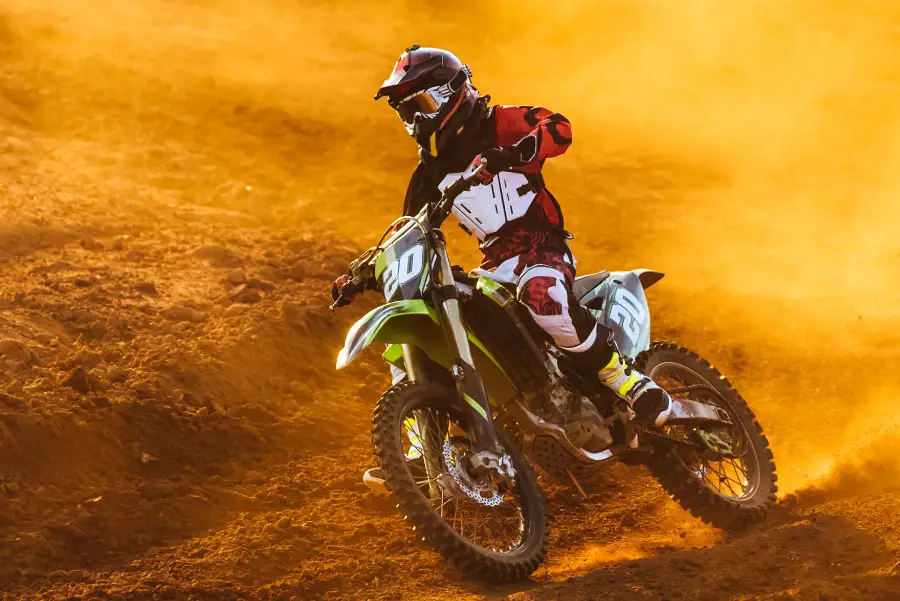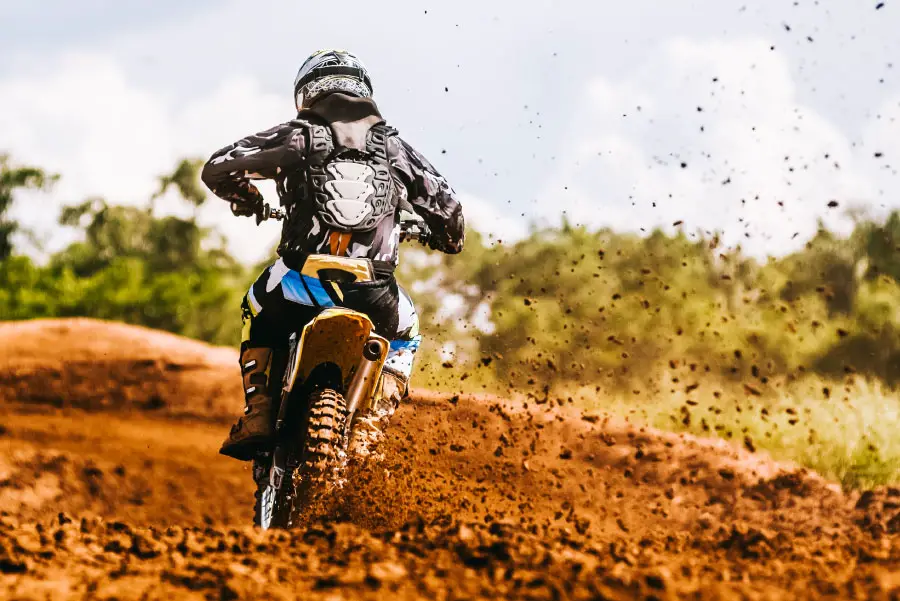
Flooding on a 2-stroke dirt bike can be a frustrating problem that can put a damper on your day out at the off-road track. There can be several causes of flooding, but how do you resolve the flooding problem in the easiest way possible and get back out on the track?
The easiest way to unflood your 2-stroke dirt bike in 5 easy steps is to:
- Remove the spark plug,
- Dry it with a cloth and then with some blasts of compressed air, or leave it in the sun.
- Leave the spark plug opening on the engine open for excess fuel to evaporate for 10 to 15 minutes.
- Replace the plug.
- Try the kick start again to start the motor.
These 5 steps may be the easy way to get your bike unflooded, but it is not necessarily the quickest method. We will expand on the five steps we have mentioned, and then cover some additional methods to unflood your dirt bike as well as some causes for flooding. In some cases, the cause of the flooding problem will need to be resolved before your dirt bike will be able to start reliably.
Step 1: Remove the spark plug
The first step is to remove the spark plug. Examining the spark plug is not only the first step but will allow you to determine if your starting problem is a flooding problem or not. Examine the electrode end of the spark plug. If it appears wet and smells strongly of fuel, then your bike is flooded, and you can continue with the next steps.
Step 2: Dry the spark plug
Dry the electrode end of the spark plug with a cloth. If you have access to a compressor, giving it a few blasts of compressed air will help to evaporate the excess fuel. If you don’t have a compressor, leaving the spark plug in the sun will do the same thing but will take a couple of minutes.
Step 3: Leave the spark plug opening open for excess fuel to evaporate
Leave the spark plug opening in the engine open to allow the excess fuel to evaporate. When doing this, however, care needs to be taken that dust and debris do not get inside the engine.
Drape a clean cloth over the opening to protect it from dirt getting in, but leave enough space for airflow. The time it will take for the excess fuel to evaporate depends on how badly flooded the bike was, but 10 to 15 minutes should be sufficient time in most cases.
Step 4: Replace the spark plug
Re-fit the spark plug in the engine. Before re-fitting the spark plug, make sure it is clean and dry. If it is not completely dry, you may need to give it a little more time to dry before fitting back in the engine. If you have spare spark plugs available, it may be beneficial to fit a new spark plug instead of the one you removed.
Make sure to fit the plug lead firmly to make a good connection once the plug is re-installed. If the lead is not connected properly, the plug will not fire, and your bike will flood again when you try to start it, and you will have to return to step 1 of the process!
Step 5: Try the kick start again to start the motor
In the fifth and last step, try to start your bike again. You may need to kick the kick start a couple of times for the cylinder to be primed with enough fuel for the spark to cause combustion. If the flooding has been resolved, your bike should start within four or five kicks.
These 5 steps that we have detailed are probably the easiest to treat a flooded bike but are not necessarily the quickest. Take a look at our bonus methods below to unflood your bike, if you are short on time or would like to try an alternative method.

Bonus Methods To Unflood Your Bike
Depending on what is causing the flooding problem on your dirt bike, some of these bonus methods can be tried to resolve the issue quicker than the easy 5-step method. These bonus methods may get your engine started faster if you are in a hurry.
Try a push start
You can try this method if your bike is not too badly flooded. Place the bike in neutral and the ignition on, get another person to give your and the bike a running push. When the bike is going fast enough, pull in the clutch, put the bike in second gear, and drop the clutch.
The additional speed and the sudden dropping of the clutch will cause a “harder” compression in the cylinder. If the flooding is not too severe, this harder compression may be enough to vaporize the fuel again and initiate combustion.
Cut off the fuel
This method will also work if the bike is not too severely flooded. Switch off the petcock valve, which it the fuel tap that turns fuel flow from the tank off and on. This will starve the carburetor of fuel, which will reduce the amount of fuel and increase the amount of air being pushed into the motor.
This may be sufficient to get the motor running. Once the engine starts, re-open the petcock valve. You can also try kicking the bike while holding the throttle wide open with the petcock closed, thus increasing the air in the fuel-air mixture.
What Happens When A Dirt Bike Floods?
What is meant by the term flooding an engine? It is essential to understand what happens when an engine floods because this knowledge may help you to prevent the flooding from occurring in the first place. This would be the ideal situation to reduce the frustration this problem can cause!
Most people understand that fuel is flammable, and that’s why we use it in combustion engines, right? What most people don’t know is that fuel in its liquid state is not as flammable as in its vapor state.
For this reason, the carburetor mixes fuel with air and sprays it into the engine cylinder as a fuel-air vapor mix. Due to the volatility of this vapor, it is much more easily ignited by the spark from the spark plug.
If combustion is not taking place, for whatever reason, the fuel entering the cylinder becomes more and more, until it once again changes from vapor to liquid form. The liquid is less combustible than the vapor, which compounds the problem. The liquid fuel makes the electrode end of the spark plug wet, which inhibits the spark generation capability of the plug.
Once the plug is wet and no longer sparking, your engine is now flooded. In other words, it is flooded with liquid fuel, which will not combust!
What Causes A Dirt Bike To Flood?
If your dirt bike floods regularly, the problem could be a symptom of an underlying issue. The bike will not work properly and will continue to flood until the underlying issue is resolved.
If you are having this flooding issue with your dirt bike, the following are some potential problems that could cause flooding. Some of them are relatively easy to check and resolve, while others may require more in-depth intervention!
Here are the causes of a dirt bike flooding:
Forgetting to close the petcock
On some bike models, leaving the petcock valve from the tank to the carb while the bike is standing will cause the fuel to flow unrestricted into the carb and cause the bike to flood. The solution to this problem is simple. You need to discipline yourself to switch the petcock off every time you stop the bike.
A Dirty Air Filter
Dirt bikes operate in dusty, dirty conditions, which can cause the air filter to become clogged. This will restrict the airflow through the air filter and make the fuel-air mixture too fuel-rich. This will result in flooding, but the problem is easily fixed. Take the air filter out and clean it, or if too badly fouled, replace it.
No Spark
The rough ground of the off-road track could jostle a pug lead loose. Secure the leads and try again. If there is still no spark, the spark plug could be faulty. Replace the spark plug and try again.
Carburetor Tuning
If the fuel-air mixture is set incorrectly on the carburetor and the fuel is set too rich, the engine will flood and stall or not start due to flooding. The solution is to set the fuel-air mixture on the carb properly.
Too Much Oil In The Fuel
In 2-stroke engines, the oil is added to the fuel in the fuel tank. If the incorrect oil or too much oil is mixed into the fuel, the excess oil will prevent the combustion of the fuel. The solution is to drain your tank of the incorrect fuel mix and re-fill it with the correct mix ratio.
Needle And Seat Problem
The carburetor has a needle and seat valve that controls the flow of fuel into the engine. If the needle is worn or the seat that it seals to is worn, the seal is no longer complete. This allows excess fuel to leak into the motor, bypassing the valve. This will cause flooding of the engine. The carburetor will need to be serviced, and the needle and seat valve replaced to correct the problem.
Old Fuel
Fuel that has been standing for a while degrades over time. The volatile component of the fuel evaporates, and a thicker sludgy residue remains. While this residue will still burn if your try to ignite it manually, it has degraded to the point that it will not combust in the engine. The solution is to never use old fuel. If the fuel is in your tank, drain the tank and replace it with fresh fuel.
Conclusion
The frustration of a flooding engine may be an exasperating problem; it is usually remedied relatively easily. Follow the steps we have detailed, and you should be riding again in no time. The only problem that may cause you to cancel your day at the track may be the need to get the carb serviced!
Happy dirt biking!


